Both feet planted firmly onto the floor, the engine revs up and holds, a resonant exhaust note echoing through the cabin. Launch Control ready, I lift my foot off the brake and am rewarded with a neck-snapping lurch that even an aircraft carrier pilot could appreciate. A mixture of gasoline, adrenaline and G forces narrow my vision as we race down the track, past 60, 80, 100 mph, before finally slamming on the brakes again.
After a series of missteps and delays, the Acura NSX is back, and our first drive reveals it was well worth the wait. In an era of mind-boggling horsepower and performance numbers, the new two-seater is neither the fastest, nor most powerful, sports car on the market, but its exotic looks, breakthrough hybrid drivetrain and uncanny ride and handling make the 2017 Acura NSX a serious contender in a crowded market.
And with its combination of hybrid power and all-wheel-drive, the new NSX is a surprisingly easy car to handle, something that could even make it a daily driver for some buyers.
(Acura set to debut new MDX at NY Auto Sh0w. Click Here for the story,)
The original Acura NSX was a breakout model for the luxury arm of Honda Motor Co. Introduced in 1990, it was the first true supercar from a Japanese manufacturer, as well as the first sports car from anywhere to use all-aluminum construction.

The 2017 Acura NSX is rated at 573 hp and 476 lb-ft, but those numbers understate its true performance.
But by the time it faded from the market in 2005, the NSX had largely been ignored by Acura and surpassed by a number of competing models. Acura made a couple of attempts at developing a replacement but couldn’t seem to find the right formula. Until a few years ago, anyway, when it decided to go for a radically alternative approach under the hood.
The concept vehicle that debuted at the Detroit Auto Show featured an unusual gas-electric drivetrain relying on a trio of electric motors: one in the back paired with a mid-mounted internal combustion engine, the others driving the front axle. The plan was to have the new NSX roll into showrooms by 2014.
The final production model, it turns out, is not just two years late but significantly revised. The gasoline-powered side of the equation is now a twin-turbo 3.5-liter V-6, and the entire powertrain package makes an impressive – if not benchmark – 573 horsepower and 476 pound-feet of torque.
The new NSX delivers power to all four wheels, but it’s not the all-wheel-drive most of us are familiar with. The bulk of that power, 500 hp and 406 pound-feet, comes from the V-6 and is applied solely to the rear wheels through a nine-speed double-clutch transmission.
Drawing power from a 0.8 kilowatt-hour lithium-ion battery, the rear motor kicks in another 47 horsepower and 109 lb-ft. The twin motors up front each make 36 ponies and 54 lb-ft of torque. If the numbers don’t quite add up, welcome to the new math of electric propulsion. Where that gas engine takes a moment to rev up and reach peak output, the electric motors are delivering maximum torque the moment they start spinning.
It’s this so-called “torque fill” that makes things so thrilling when you stomp on the throttle – delivering an estimated 1.3 Gs when you use launch mode. While Acura isn’t offering performance numbers, initial indications are that you’ll hit 60 in three seconds or less.
(Exclusive: Acura considering even brawnier NSX Type-R. Click Here for the story.)
The 2017 Acura NSX is a far more striking entry than the original two-seater, which had a decidedly ungainly, albeit distinctive design. The production version has undergone a number of changes since we saw the first concept version four years ago, the result of a major decision made late in the development process.
Disappointed with initial performance numbers, Acura decided to beef up the internal combustion side of the package. It abandoned the transverse-mounted, naturally aspirated V-6 of the concept in favor of the current, longitudinal layout and twin-turbo six.
That switch required it to widen the rear of the sports car, and to boost its breathing capabilities. Among other things, that has translated into wider scoops immediately behind the doors. The changes posed some serious challenges to Acura designers – who had a mandate to maximize aerodynamics – but, in the end, it yielded a much more visually dynamic look.
As with the original car, Acura put a premium on delivering a stiff, lightweight body and platform, and while they didn’t go all the way with the sort of carbon fiber tub layout of a McLaren, they did opt for a blend of aluminum and carbon fiber that can stand up against even such vaunted competitors as the Ferrari 458.
You can also load up with a number of substitute carbon parts, including a $6,000 roof and $3,600 engine cover, as well as the lighter, more fade-resistant carbon-ceramic brakes. They’re a $9,000 option. Oh, and in case you are wondering about price, the NSX starts at $158,000 plus delivery charges. But you can very quickly nudge it up to around $210,000 if you add in those appearance pieces, the audio and tech package and all the other available options.
Visually, the new NSX is more McLaren than Ferrari. One should use the word, “understated” cautiously. It is an absolute head-turner, as we discovered during a long day of track and street driving in and around Palm Springs. But the Acura team opted to go for a more subtle look than their Italian rival – or, for that matter, than what Ford has done with the reincarnated GT.
Inside, however, the new NSX is brilliantly executed, with the right blend of luxury and performance cues. The steering wheel shows the sort of attention Acura once was known for. The leather wrapping seamless so as not to chafe on one’s hands when doing high-speed maneuvers. The gauges are well placed and easy to read, and they change color and layout depending upon which mode you’re operating in.
Some buyers might chafe a bit at the quirky transmission shifter, with its mix of buttons and squares, lifted from more mainstream Acura models, such as the RDX. Our big complaint is the center stack-mounted infotainment display. It uses the same touchscreen layout as you’ll find in the Honda Fit. It’s neither visually appealing nor especially pleasing to use. But the rest of the package more than makes up for that shortfall, especially when you fire up the powertrain.
Actually, the NSX starts up in what Acura calls “Quiet Mode.” This is a hybrid, not a plug-in, so it only yields a brief run on battery power alone. But while it does, the NSX can slink by almost silently.
Now, shift to one of the sport or track options and it’s another manner – at least inside. There’s a small pipe that delivers a bit of real intake noise into the cabin, and the effect is quite thrilling when you’re blasting down the front straight. Outside, however, the new Acura NSX is not nearly as loud as comparable sports cars using a more conventional drivetrain – even though an active exhaust valve that bypasses the mufflers in Track Mode kicks in an added 25 decibels.
On track or off, you’re likely to be quickly impressed by the new sports car’s ride and handling. The suspension is a front double-wishbone, rear multi-link layout. And the NSX goes with magnetic rheological dampers. That’s basically the same system found in the Corvette Z06 and several new Ferraris, among others. The system relies on a magnetically controlled fluid that can shift from soft to rock-solid in the time it takes to travel one inch at 60 mph.
The NSX uses a variable ratio electronic power steering system that is speed sensitive – and, along with the throttle, transmission and other functions – 11 in all — is automatically adjusted by the mode the driver selects.
But what really makes the difference is the electric side of the drivetrain layout. Up front, the two motors each drive a different wheel. Go hard into a corner and the system boosts torque to the outer wheel while cutting back power to the inner wheel. It effectively helps steer you through a turn, rather than pushing the car like a conventional all-wheel-drive system.
The concept is known as torque vectoring, but it’s far less of a Rube Goldberg affair than you have with a conventional drivetrain, where a vehicle has to apply the brake on the inner wheel to help turn.
The NSX package is completed by a complex braking system that scrubs off speed smoothly and quickly – while also helping recharge that lithium-ion battery pack. Conventional metal brakes are standard, but we anticipate a fair share of buyers will opt for the carbon fiber package. That not only shaves off 52 pounds of mass but also virtually eliminates fade after even the hardest track maneuvers.
Mass is an issue. That complex drivetrain and lithium battery pack add a lot of weight. At 3,800 pounds, the new NSX is more than 600 pounds heavier than, say, a Lamborghini Huracan. But by keeping that weight low, you’ll rarely feel it from behind the wheel.
Was it worth the wait? That likely depends on what you’re looking for. The 2017 Acura NSX is a handsome car, if not the most dynamic of designs. It’s fast, a lot quicker than the raw horsepower and torque numbers might suggest. It’s got a great interior, albeit with a few shortfalls. And it delivers truly amazing handling on track and on the street.
We’re expecting it will bring a lot of buyers into Acura showrooms – and the maker could certainly use the traffic. Like the original, the 2017 Acura NSX is likely to take a lot of folks by pleasant surprise.
(Bugatti reveals 261 mph Chiron. Click Here to check it out.)

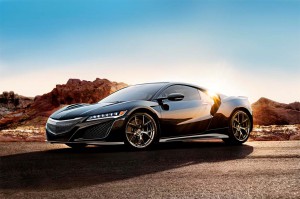

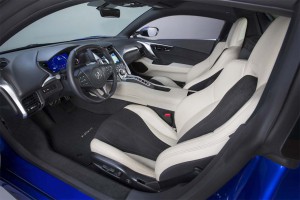
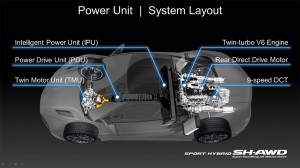
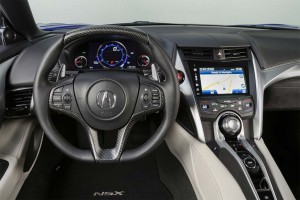

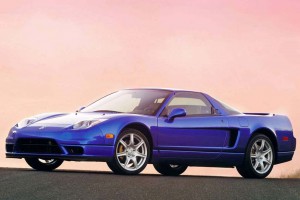
You had me, at least right up until the part about those 3800 lbs.